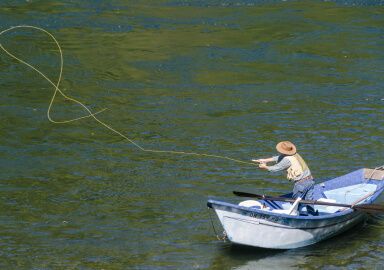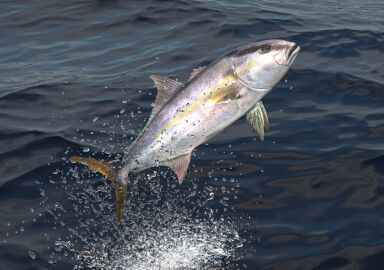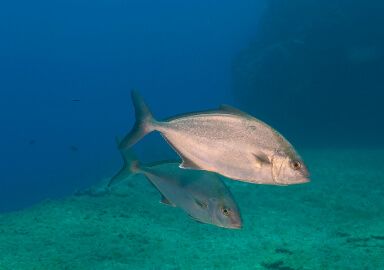Greater Amberjack
Greater amberjack are a very large top fish predator found in deep, warm ocean waters near wrecks and reefs.
View 8 listings
8
listings
–
price starting from
6
countries
–
to the nearest trip
Where and When?
Greater amberjack have a circum-global distribution in many temperate, tropical and sub-tropical ocean waters. They can be particularly common off Australia, South Africa, Hawaii, Bermuda and parts of the eastern seaboard of the USA up to Nova Scotia. They are an important recreational species around Florida, the Caribbean Sea and parts of the Gulf of Mexico. Juveniles, less than about 3 kg (6.6 lbs.), can be caught fairly close inshore around reefs and wrecks but most adults are caught in much deeper waters of 18-72 m. (360-1 180 ft.). They move throughout the water column but seem to spend most of their time fairly near the bottom and favour canyons and reefs. No large-scale migrations have yet been identified but there is an apparent movement into cooler water parts of their range as summer approaches and the opposite in fall. They can be caught throughout the year but, in temperate areas, are more often caught in summer. Most fishing is carried out during daylight and, as the fish are usually quite deep, the time of day is not of great importance.
About Greater Amberjack
The greater amberjack (Seriola dumerili) is the largest member of the Carangidae family that contains the trevallys, pompanos and jacks. They are usually brownish to blueish grey above and a silvery white on the belly. They also have a distinct diagonal sooty stripe from their upper jaw through their eye to their tail fin. Their body is covered in very small scales and they have a medium sized mouth at the front of the head.
The greater amberjack have elongate, laterally compressed bodies and, apart from size, both sexes are identical. Sex is determined early and they remain the same sex throughout life. They are opportunistic predators, mostly on fish, but their diet also includes cephalopods like squid. The largest recorded greater amberjack was 190 cm (75 in.) weighing 80.6 kg (178 lbs.) but they are more often caught around 100 cm (39 in.). Larvae are planktonic, juveniles are usually found in-shore while adults tend to favour offshore, deep, water, and love reefs and wrecks. They are usually solitary, particularly when adults, but can form shoals during their spawning season.
How to Catch?
Greater amberjack have a reputation for being one of the strongest and most stubborn gamefish. They are voracious predators and yet very difficult to successfully land. This is because a large greater amberjack will exert enormous pressure on your tackle and your skill. If you are using medium tackle and targeting other species when you “pick up” a good-sized greater amberjack, you will probably lose your fish as well as some equipment and your sense of humour. The best way to catch greater amberjack off places such as Florida is to charter one of the many excellent local outfits. Go to known reefs in water of 75-90 m. (250-300 ft.) and drop down a suitable live bait such as a “google eyes” and await developments. If your bait is well hooked, using a circle hook, when a greater amberjack takes off, all you have to do is tighten the drag to set the hook.
Artificial baits, such as jigs, also work and, once a good fish is hooked, the fun really begins. Hooking a large greater amberjack is probably less than half the story as their sheer determination and strength all too often results in tackle or skill failure and sadness. On the other hand, successfully landing a good greater amberjack gives an enormous sense of satisfaction and, as they are not the best tasting fish, releasing the fish is a satisfying and appropriate end to a wonderful fishing experience.









